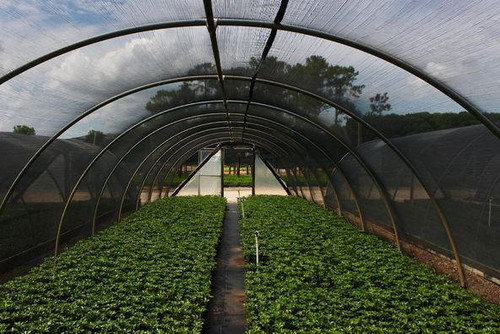Product Description
Pachysandra terminalis 'Silver Edge' Bare Root Plants
Common Name: Silver Edge Pachysandra
- Height: 6-8 Inches
- Hardiness Zone: 4-9
- Shade
- Tolerates part sun in Northern Zones
- Evergreen ground cover
- Spreads by rhizomes
Pachysandra terminalis 'Silver Edge' is a cultivar of Japanese spurge that is known for its glossy, dark green, oval and slightly curled leaves with a silvery white margin. It is a more compact and less aggressive grower than the species plant, making it a good choice for smaller gardens. This variety was selected for its distinctive foliage, which can add a touch of brightness to shady areas.
Japanese spurge grows to a height of 6-12 inches and quickly spreads by underground rhizomes to a width of 24-36 inches. The flowers are small 1"-2" white spikes emerging in spring.
Japanese spurge prefers part shade to full shade. Morning sun in the North is okay, but Southern gardens need shade. Plant in moist, organically rich, loamy, well-drained soil. Not particularly drought-tolerant, so water as needed.
Versatile and easy-care groundcover, Pachysandra terminalis is a great option. The plant is attractive, drought-tolerant, and can be used in a variety of settings. Japanese spurge tolerates foot traffic and a popular choice for groundcover, ornamental borders and rock gardens.
Pachysandra terminalis 'Silver Edge' is a delightful variegated form of the popular Japanese Spurge groundcover. It is a great choice for adding a touch of brightness and texture to shady areas of your garden. Here is a closer look at what makes it so special:
Appearance and Characteristics:
- Striking Variegation: The most distinctive feature of 'Silver Edge' is its leaves. They are a glossy dark green with a crisp, silvery-white margin, creating a beautiful contrast. This variegation adds visual interest and brightens up even the shadiest corners.
- Evergreen Foliage: Like its parent species, 'Silver Edge' boasts evergreen foliage, providing year-round interest and a reliable ground cover.
- Low-Growing and Spreading: It is a low-growing plant, typically reaching about 6-10 inches in height. It spreads by underground rhizomes, gradually forming a dense mat of foliage.
- Small Flowers: In spring, it produces small, inconspicuous white flowers that are often hidden beneath the foliage. While not showy, they add a subtle charm.
Growing Conditions:
- Shade Lover: 'Silver Edge' thrives in partial to full shade. It is an excellent choice for under trees, in woodland gardens, or on the north side of a building.
- Well-Drained Soil: It prefers well-drained soil that is rich in organic matter. However, it can tolerate a variety of soil types as long as they are not waterlogged.
- Hardiness Zones: It is typically hardy in USDA zones 5-9.
Uses in Landscaping:
- Groundcover: Its primary use is as a groundcover, where it creates a dense and attractive carpet of variegated foliage.
- Edging: It can be used to create a neat and colorful border along pathways or flower beds.
- Underplanting: It is an excellent choice for underplanting trees and shrubs, as it tolerates shade and helps to suppress weeds.
Benefits:
- Year-round Interest: The evergreen foliage and striking variegation provide visual interest throughout the year.
- Low Maintenance: Once established, it requires minimal care.
- Weed Suppression: It forms a dense mat that helps to suppress weeds.
- Deer Resistant: Deer tend to avoid eating Pachysandra.
Potential Drawbacks:
- Slow Spreading: Compared to some other groundcovers, 'Silver Edge' spreads relatively slowly.
- Can be Expensive: Due to its variegated nature, it can be more expensive than the non-variegated Pachysandra terminalis.
Additional Tips:
- Planting: The best time to plant 'Silver Edge' is in the spring or fall.
- Spacing: Space plants about 12-18 inches apart to allow for spreading.
- Maintenance: Trim back any dead or damaged foliage in early spring.
Overall, Pachysandra terminalis 'Silver Edge' is a beautiful and reliable groundcover that adds a touch of elegance to shady areas. Its variegated foliage, low-maintenance requirements, and deer resistance make it a popular choice for gardeners.
Other Details
The most important part of the plant is its root system. Healthy roots are the foundation of a healthy, vibrant plant. The type of plug container used is based on the specific needs of the plants. Perennials offered as bare root traditionally perform better when planted as bare root.Planted in a specialized mix, potted plants have well established root systems. Top growth stage will vary depending on the current life cycle and time of year when shipped. In Winter and early Spring dormant plants may be shipped. Dormant plants may be planted right away, even before the last frost date.
Most bare root varieties are field grown for at least one season, though Hemerocallis and Hosta are grown for two seasons. The bulk of the soil is removed during the harvesting process and the tops of most varieties are trimmed back to the crown. They are graded, packed in shredded aspen or sphagnum moss and stored in freezers until ready to be shipped.
See our Container Sizes and Bare Root Perennials pages for more information.
Plant information and care is provided in the Overview section, Plant Genus Page and general information is provided in the Planting Care & Guides. Additional questions can be asked on each Plant page.
Plant Spacing: Using the maximum mature spread or width of a plant to guide spacing, ensures space to grow to full size. To fill an area sooner, plant them closer together. Just remember, future thinning or transplanting may be needed.
Water: Keep a close eye on newly planted perennials, especially throughout the first growing year. Most early plant loss is due to too much or too little water!








